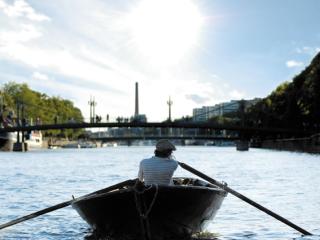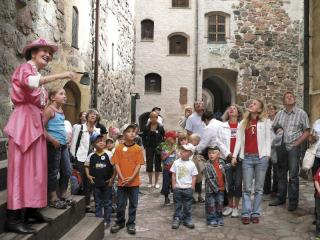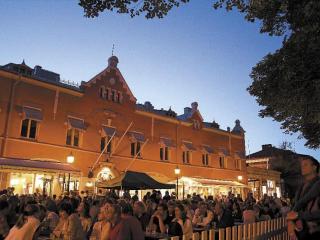Turku, Finland’s “First City”, dates back to 1280 when Swedish, Danish and Finnish merchants met 0n Finland’s southwest coast at the mouth of the Aura River to trade goods. Over time Turku needed a cathedral (consecrated in 1300) and a bishop to govern the unruly heathens attracted by the marketplace. This region, Finland Proper, was the heart of the country in terms of its wealth, political power and prestige for  more than 500 years. Moreover, Turku’s beginnings as a merchant hub, as well as its exquisite cathedral and castle, provided Finland’s secular and non-secular leaders protection and status. Much of Finland’s past, however, was spent as a territory of some stronger, imperial, neighbor nation: Sweden or Russia or a combination of both. But after Finland broke free, Turku became the capital from 1809 until 1812 when the seat of government was moved to Helsinke. Turku continued to be Finland’s largest and most populous city until the 1840s.
more than 500 years. Moreover, Turku’s beginnings as a merchant hub, as well as its exquisite cathedral and castle, provided Finland’s secular and non-secular leaders protection and status. Much of Finland’s past, however, was spent as a territory of some stronger, imperial, neighbor nation: Sweden or Russia or a combination of both. But after Finland broke free, Turku became the capital from 1809 until 1812 when the seat of government was moved to Helsinke. Turku continued to be Finland’s largest and most populous city until the 1840s.
With a population of 175,000, Turku is now the fifth largest city in Finland. Today, Turku is a relic of Europe’s storied history, much like dozens of other small, walled in cathedral towns scattered all over the continent. For Americans (and other non-European) travelers, these towns are exactly what bring us to Europe time and again. We don’t have ancient cathedrals and castles in the USA and our heroes are from the musket era. Whereas, towns like Turku entertained knights and Vikings and princes in their time.
A visit to the Turku Castle and museum is an essential part of any trip to this region, though it is not necessarily the most important. Finland is a beautiful country of islands, fjords, forests and mountains. In the southwest, upriver from Turku, there is the Green Triangle, a collection of rolling green parks connected by nature trails and mountain hikes. The Turku Archipelago is one of the largest in the world and is also conveniently connected by bridges and roads. Several of the islands are tourist-friendly with food and lodging available, others are strictly for the visitor, who wants a glimpse of the sea from a windy atoll.
Since its founding, Turku has always been a gateway to Europe and to Finland’s interior. The city’s proximity to Sweden and the rest of Europe made the citizens of Turku more open to strangers and their ways. Sweden ruled Finland from Turku for a period of time and Finland’s first Swedish language university was founded here. Turku was also among the first to reach-out to the Soviet Union in order to foster understanding between East and  West. Almost all towns that begin as market places seem to maintain that laissez faire attitude towards “foreigners” and their strange customs and religions — this along with a healthy dose of education. Finland’s first university, first school and first international school were established here and there are currently more than 30,000 students in Turku at any given time.
West. Almost all towns that begin as market places seem to maintain that laissez faire attitude towards “foreigners” and their strange customs and religions — this along with a healthy dose of education. Finland’s first university, first school and first international school were established here and there are currently more than 30,000 students in Turku at any given time.
Given its history and modern demographics, its not surprising to hear that  Turku holds several rock festivals each year, including one of the largest electronic festivals in Europe, Down by the Laituri, held toward the end of July, which fills the streets every year. During the summer, its important to know that Turku will have some sun until roughly midnight. This makes the “nightlife” rather more raucous then you would expect from an old ex-capital on the fringes of Europa. There are many, many pubs in Turku (to insulate during the cold winter and enable during the burst-out of summer) — a favorite spot is along the Aura River where pub boats tie up to the bank and fill up with guests having a pre-stroll drink. July might just be the best time to visit weather wise, culturally and for fun: the sun is up for 18 hours, the Medieval Market starts in July and the festivals roll in toward the end of the month.
Turku holds several rock festivals each year, including one of the largest electronic festivals in Europe, Down by the Laituri, held toward the end of July, which fills the streets every year. During the summer, its important to know that Turku will have some sun until roughly midnight. This makes the “nightlife” rather more raucous then you would expect from an old ex-capital on the fringes of Europa. There are many, many pubs in Turku (to insulate during the cold winter and enable during the burst-out of summer) — a favorite spot is along the Aura River where pub boats tie up to the bank and fill up with guests having a pre-stroll drink. July might just be the best time to visit weather wise, culturally and for fun: the sun is up for 18 hours, the Medieval Market starts in July and the festivals roll in toward the end of the month.


Comments